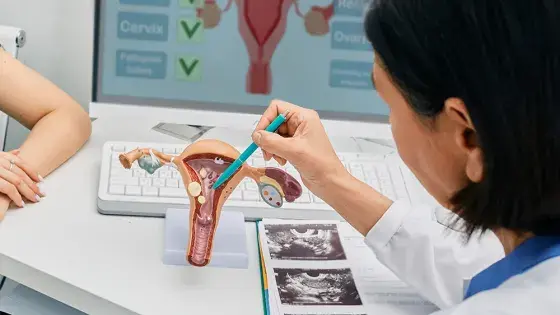Cancers that start in the female* reproductive system are called gynaecological cancers. These cancer types can affect women, some transgender men and non-binary people assigned female at birth. In this article, we will explore the different types of gynaecological cancer.
Cervical Cancer
Cervical cancer originates in the cells lining the cervix - the lower part of the uterus that connects to the vagina.
It is often associated with the human papillomavirus (HPV), a sexually transmitted infection. Regular cervical screening (otherwise known as smear tests) are crucial as they can detect abnormal cells before they potentially turn into cancer. Symptoms of cervical cancer may not be apparent in the early stages, but can include irregular bleeding (such as bleeding between periods, after sexual intercourse or following menopause), an unpleasant smelling vaginal discharge and pain during sex.
Certain factors can increase a woman's risk of developing cervical cancer. The main factor is infection with high-risk HPV types, but smoking, having an immune system weakened by HIV/AIDS, a family history of cervical cancer, taking birth control pills for a long time or having multiple full-term pregnancies are also associated with increased risk. The HPV vaccine - recommended for children from 11 years old and people at higher risk from HPV (free for all girls under 25 on the NHS) - offers significant protection against the strains of HPV most commonly linked to cervical cancer and it is an important preventive measure.
Ovarian Cancer
Ovarian cancer originates in the ovaries, which are part of the female reproductive system and responsible for producing eggs, as well as the hormones oestrogen and progesterone. It is a particularly challenging form of cancer to detect early, as it often presents with subtle symptoms that can easily be mistaken for less serious conditions. Symptoms can include bloating, pelvic or abdominal pain, difficulty eating or feeling full quickly and urinary symptoms such as urgency or frequency. These symptoms are common and often not immediately associated with ovarian cancer, which is why it is sometimes referred to as the "silent killer."
Risk factors for developing ovarian cancer include older age, a family history of ovarian or breast cancer, inherited genetic mutations such as faulty versions of BRCA1 or BRCA2, smoking, being overweight or obese, endometriosis, diabetes and postmenopausal hormone replacement therapy. There is no routine screening test for ovarian cancer, so it's essential for women to be aware of the risks and symptoms and to consult their doctor if they experience any persistent changes in their health. Early-stage ovarian cancer is more treatable, making awareness and prompt attention to symptoms critically important.
Uterine (Endometrial) Cancer
Uterine cancer, also known as endometrial cancer, arises from the cells lining the uterus or endometrium and is now the most common type of cancer affecting the female reproductive organs in many developed countries.
The most frequent sign of uterine cancer is abnormal vaginal bleeding. This can include changes in menstruation (for example, heavier periods than usual), bleeding between periods, or postmenopausal bleeding. Other symptoms may include pelvic pain, pain during intercourse and an unusual, watery or blood-tinged vaginal discharge.
Several risk factors are associated with an increased risk of developing uterine cancer. These include increasing age, obesity, having a history of atypical endometrial hyperplasia (thickening of the womb lining), using oestrogen-only hormone replacement therapy, polycystic ovarian syndrome, and certain inherited conditions, such as Lynch syndrome.
There is no standard screening program for uterine cancer, so it's important for women to be alert to symptoms and to discuss any concerns with their healthcare provider. Early detection is key, as treatment is often more effective when the cancer is found at an early stage.
Vaginal Cancer
Vaginal cancer is a rare type of cancer that forms in the vaginal tissue. It is more common in older women, with the majority of cases diagnosed in those over the age of 60. Recognising symptoms can be challenging, as early stages of vaginal cancer may not present any signs. However, as the cancer progresses, symptoms such as abnormal vaginal bleeding, unusual vaginal discharge, discomfort during intercourse, a lump or mass in the vagina and pain when urinating, can emerge.
Risk factors for vaginal cancer include: exposure to the human papillomavirus (HPV), having a weakened immune system, increasing age, a history of cervical cancer or precancerous conditions of the cervix, smoking, and exposure to the drug diethylstilbestrol (DES) in utero. There is no routine screening test specifically for vaginal cancer, but it’s beneficial for women to attend regular cervical screening appointments, as these can detect changes that may be related to vaginal cancer. Vaccination against HPV can also help prevent certain types of vaginal cancer linked to the virus.
Vulvar Cancer
Vulvar cancer is another rare form of cancer affecting women, which occurs on the vulva, the external part of the female genitalia. This type of cancer is most frequently diagnosed in older women, particularly those over the age of 65. Symptoms can include persistent itching or pain around the vulva, changes in the vulvar skin such as thickening, a rash or a growth, or the presence of an ulcer or lump that doesn't heal.
Other risk factors for developing vulvar cancer include: a history of HPV infection (which is a significant contributor to many cases), smoking, having a weakened immune system, and having a skin condition affecting the vulva (such as lichen sclerosis or pre-cancerous skin changes). There is no screening program for vulvar cancer, so it's essential for women to be attentive to any abnormalities or changes in appearance and to seek medical advice if they notice anything unusual.
Gynaecological cancers represent a diverse group of diseases that require a nuanced understanding for effective management and treatment. Awareness of the symptoms, risk factors and preventive measures is crucial for early detection and improved outcomes.
*women, trans men, people who are non-binary who were assigned female at birth and cis gender women

